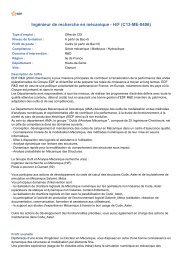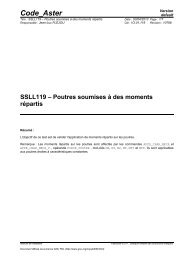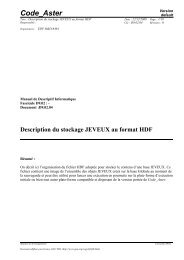U1.03.01 - Code_Aster
U1.03.01 - Code_Aster
U1.03.01 - Code_Aster
You also want an ePaper? Increase the reach of your titles
YUMPU automatically turns print PDFs into web optimized ePapers that Google loves.
<strong>Code</strong>_<strong>Aster</strong><br />
Titre : Superviseur et langage de commande<br />
Version<br />
default<br />
Date : 08/05/2012 Page : 12/16<br />
Responsable : Christophe DURAND Clé : <strong>U1.03.01</strong> Révision : 8998<br />
5 Usage of python in the command files<br />
It is not necessary to know the language python to use <strong>Code</strong>_<strong>Aster</strong>. Indeed, with the help of some<br />
basic rules to respect on the indentation and parenthesizing, only the knowledge of the process control<br />
language describes in the catalogues of command is necessary. And still, EFICAS makes it possible<br />
to be exempted to resort to the catalogue or the paragraph “syntax” of the commands by proposing the<br />
key words graphically to inform.<br />
However, the advanced user will be able to use cheaply the power of language PYTHON in his<br />
command file, since the aforementioned is already written in this language.<br />
The four main uses can be: the writing of personalized macro-commands, the use of general<br />
instructions python, the importation of useful moduli python, the recovery of information of the<br />
<strong>Code</strong>_<strong>Aster</strong> data structures in variables PYTHON.<br />
Note:<br />
If one wants to use French characters accentuated in the command file or the moduli<br />
imported, it is necessary to place the following instruction in first or second-row forward of<br />
the file:<br />
# - * - coding: Iso-8859-1 - *En<br />
python 2.3, the absence of this line causes a warning which will become an error in python<br />
2.4; in ASTER, it is systematically an error.<br />
5.1 personalized Macro-commands<br />
Voir the document [D5.01.02]: “Introduce a new macro-command”.<br />
The personalized macro-commands are very easy to program. They can be used for capitalizing<br />
recurring diagrams of computation and thus constituting a tool-trade. It is strongly advised to take<br />
example on the existing macro-commands: Macro package in the directory bibpyt.<br />
5.2 General instructions PYTHON and useful moduli<br />
Les advanced users can benefit great from the use of loops (for), of tests (yew), the exceptions (try,<br />
except) and in a general way of all the power of language PYTHON directly in their command file. The<br />
list of the uses is impossible to establish exhaustively. Many examples are present in the cases tests<br />
of the base of tests. One can for example make mesh adaptation while placing the sequence<br />
computation/mending of meshes in a loop, establish stopping criteria of the iterations by a test on a<br />
computed value.<br />
Consult the next paragraph dedicated to the “particularized” <strong>Aster</strong> exceptions.<br />
In a loop, if an already existing concept is recreated, it is necessary to think of destroying it as a<br />
preliminary by command DETRUIRE.<br />
The other various functionalities of python interesting for the user of <strong>Code</strong>_<strong>Aster</strong> can be:<br />
the read-write on file,<br />
numerical computation (for example by using Numerical Python),<br />
the call via the modulus bone with the scripting language, and in particular the launching of a<br />
third code (os.system)<br />
the handling of character strings<br />
the call to graphic moduli (grace, gnuplot)<br />
5.3 Exceptions PYTHON of the modulus aster<br />
Warning : The translation process used on this website is a "Machine Translation". It may be imprecise and inaccurate in whole or in part and is<br />
provided as a convenience.<br />
Licensed under the terms of the GNU FDL (http://www.gnu.org/copyleft/fdl.html)




![[V5.02.132] SDNL132 - Pendule rigide avec contacts ... - Code_Aster](https://img.yumpu.com/22011747/1/184x260/v502132-sdnl132-pendule-rigide-avec-contacts-code-aster.jpg?quality=85)
![[R5.03.22] Constitutive law in large rotations and small ... - Code_Aster](https://img.yumpu.com/22011735/1/184x260/r50322-constitutive-law-in-large-rotations-and-small-code-aster.jpg?quality=85)
![SSLV135 – Critères d'amorçage en fatigue sous char[...] - Code_Aster](https://img.yumpu.com/22011730/1/184x260/sslv135-criteres-damorcage-en-fatigue-sous-char-code-aster.jpg?quality=85)
![[U2.08.03] Operating instructions for linear solvers - Code_Aster](https://img.yumpu.com/19451713/1/184x260/u20803-operating-instructions-for-linear-solvers-code-aster.jpg?quality=85)
![SSLS130 - Zoom structural : plaque trouée soumise [...] - Code_Aster](https://img.yumpu.com/19451712/1/184x260/ssls130-zoom-structural-plaque-trouee-soumise-code-aster.jpg?quality=85)
![[U4.90.03] Macro-commande OBSERVATION - Code_Aster](https://img.yumpu.com/18316250/1/184x260/u49003-macro-commande-observation-code-aster.jpg?quality=85)
![[R7.20.01] Projection of a field on a mesh - Code_Aster](https://img.yumpu.com/17613309/1/184x260/r72001-projection-of-a-field-on-a-mesh-code-aster.jpg?quality=85)
![MTLP103 - Trempe d'un barreau cylindrique en acier[...] - Code_Aster](https://img.yumpu.com/17583463/1/184x260/mtlp103-trempe-dun-barreau-cylindrique-en-acier-code-aster.jpg?quality=85)

![SSNS111 - Flexion d'une dalle en béton armé sous c[...] - Code_Aster](https://img.yumpu.com/17299553/1/184x260/ssns111-flexion-dune-dalle-en-beton-arme-sous-c-code-aster.jpg?quality=85)


![[U1.03.02] Méthodes Python d'accès aux objets Aster - Code_Aster](https://img.yumpu.com/17211538/1/184x260/u10302-methodes-python-dacces-aux-objets-aster-code-aster.jpg?quality=85)
![[U7.05.21] Procedure IMPR_RESU - Code_Aster](https://img.yumpu.com/17208904/1/184x260/u70521-procedure-impr-resu-code-aster.jpg?quality=85)